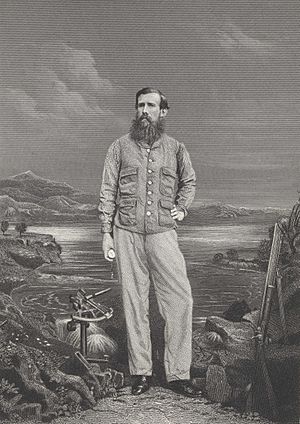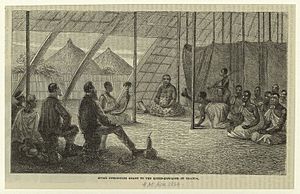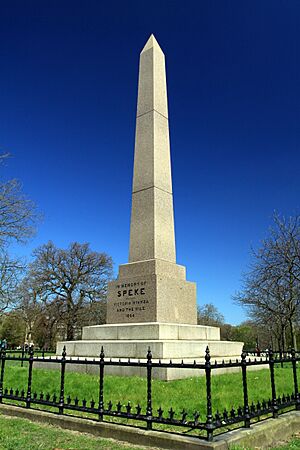John Hanning Speke facts for kids
Quick facts for kids
John Hanning Speke
|
|
|---|---|
 |
|
| Born | 4 May 1827 |
| Died | 15 September 1864 (aged 37) Neston Park, Wiltshire, England
|
| Burial place | Dowlish Wake, Somerset, England |
| Occupation | Military officer and explorer |
John Hanning Speke (born May 4, 1827 – died September 15, 1864) was an English explorer and an officer in the British Indian Army. He made three important trips to Africa. He is best known for searching for the source of the Nile River. He was the first European to reach Lake Victoria, which local people called Nam Lolwe or Nnalubaale.
Speke also suggested a theory in 1863 about different groups of people in Africa. He thought that the Tutsi people were descendants of a biblical figure named Ham. He believed they had lighter skin and different features than the Hutu people, over whom he thought they ruled. This idea was later seen as unhelpful and harmful.
Contents
Early Life and First Adventures
Speke was born on May 4, 1827, in Buckland Brewer, England. In 1844, he joined the British Army and was sent to British India. He served in the army during the Punjab campaign and the First Anglo-Sikh War. He became a lieutenant in 1850 and a captain in 1852. During his time off, he explored the Himalayas and even went into Tibet.
First Trip to Africa
In 1854, Speke went on his first trip to Africa. He wanted to collect animal and plant samples for his family's museum. He joined an expedition to Somalia led by the famous explorer Richard Francis Burton.
During this trip, Speke and Burton faced many challenges. They were attacked by about 200 armed Somalis while camping. Speke showed great bravery during the attack, shooting at several attackers. He was wounded and captured but managed to escape. This difficult experience, along with a misunderstanding during the attack, created problems between Speke and Burton that would grow later. The expedition lost money, and Speke's collected specimens were used to help cover the costs.
Searching for the Nile's Source (1856–1859)
In 1856, Speke and Burton traveled to East Africa. Their goal was to find the Great Lakes in the middle of the continent, hoping one of them would be the source of the Nile River. They started their journey from Zanzibar Island in June 1857.
The trip was very hard. Both men became sick with tropical diseases. After traveling over 600 miles on foot and by donkey, they reached Kazeh (Tabora) in November 1857. They rested there among Arab traders. As they continued west, Burton became very ill, and Speke temporarily lost his sight.
In February 1858, they reached Ujiji and became the first Europeans to see Lake Tanganyika. Speke, though still partly blind, tried to explore the huge lake. He crossed part of it in a small canoe. During this journey, a beetle crawled into his ear, and he tried to remove it with a knife, which made him temporarily deaf. They couldn't fully explore Lake Tanganyika and were unsure if a river flowed out of it to the north.
Speke Discovers Lake Victoria
They heard about another large lake to the north-east. In May 1858, they decided to explore it on their way back to the coast. Burton was too weak to go, so Speke went alone on a 47-day side trip.
On July 30, 1858, Speke became the first European to see Lake Victoria. He named it after British Queen Victoria. This lake later proved to be the true source of the Nile River. Speke made the first map of the lake. He estimated its height by checking the temperature at which water boiled. This suggested it was higher than Lake Tanganyika, making it a better candidate for the Nile's source.
The relationship between Speke and Burton became worse during this time. Burton saw Speke as less experienced, but Burton himself struggled to manage their travel group. Speke, who enjoyed hunting, provided meat for the group, which helped keep them motivated. When it seemed Speke had found the Nile's source, their disagreements grew.
The efforts of their guides, Sidi Mubarak Bombay and Mabruki, were very important in discovering the lake. Bombay had been captured as a child and sold to Indian merchants, so he spoke Hindustani. He also spoke several local languages, which helped the expedition greatly. Speke praised Bombay's honesty and hard work. Both Bombay and Mabruki later became famous caravan leaders in East Africa.
Returning to England and the Nile Debate
Speke and Burton began their return journey in September 1858. They had to go back because their military leaves were ending. They both suffered from severe illnesses and had to be carried by porters for parts of the trip.
Once back in England, more disagreements started. Burton accused Speke of breaking a promise not to announce their findings publicly until they were both back. Burton then changed his mind and argued that Lake Victoria was not the Nile's source. The arguments between them grew, fueled by their friends and the media.
Burton was still very weak and couldn't convince the Royal Geographical Society (RGS) to let him lead another expedition. Instead, Speke was chosen to lead the next trip. The two men presented their findings together to the RGS on June 13, 1859.
Second Journey to the Nile's Source (1860-1861)
Speke started his second expedition with James Augustus Grant. They left England in April 1860 and Zanzibar in October 1860. They approached Lake Victoria from the south-west. Grant was often sick and couldn't travel with Speke much of the time.
Travel in central Africa was difficult due to slave traders, which made local tribes distrustful of outsiders. Speke and Grant had to offer gifts and pay fees to local chiefs, which caused delays and used up their supplies.
After many months, Speke reached Lake Victoria again on July 28, 1862. He traveled along the western side of the lake. On the north side, Speke finally found the Nile River flowing out of the lake and discovered the Ripon Falls.

Speke was given permission by King Muteesa I of Buganda to leave in June 1862. He then traveled down the Nile, meeting up with Grant again. Because of travel restrictions, tribal wars, and difficult land, Speke could not map the entire flow of the Nile from Lake Victoria north.
By January 1863, Speke and Grant reached Gondokoro in South Sudan. There, Speke met Samuel Baker and his wife, Florence. Speke sent a famous telegram to London: "The Nile is settled."
However, the issue was not fully settled. Burton argued that because Speke had not followed the Nile all the way from Lake Victoria to Gondokoro, he couldn't be completely sure it was the same river. Baker and Florence continued exploring south from Gondokoro and eventually found Lake Albert and the Murchison Falls.
Return to London and Later Years
Speke and Grant returned to England in June 1863 and were first welcomed as heroes. But this didn't last for Speke. Disputes with Burton, who was a strong public speaker and writer, made Speke's discoveries seem less certain. Speke also struggled to write his book and give a full report to the RGS, which hurt his reputation.
These problems led Roderick Murchison, the president of the Royal Geographical Society, to become less supportive of Speke. A third expedition led by Speke became unlikely. The RGS then asked for a public debate between Speke and Burton to finally settle the question of the Nile's source.
Death
A debate between Speke and Burton was planned for September 16, 1864. However, Speke died the day before, on September 15, from a gunshot wound while hunting at Neston Park in Wiltshire. An investigation concluded that his death was an accident. Speke was buried in St Andrew's Church, Dowlish Wake in Somerset.
The Nile's Source Confirmed (1874–1877)
Between 1874 and 1877, Henry Morton Stanley led a new expedition. He traveled by boat along the entire shore of Lake Victoria. He proved that Lake Tanganyika and the Nile were not connected. He also explored the upper parts of Lake Edward. It was finally confirmed that Speke had been right all along: the Nile flowed from Lake Victoria, through Ripon Falls and Murchison Falls, to Lake Albert, and then to Gondokoro.
Scientific Ideas
In his book, Speke wrote about his observations of different African groups. He believed he found a "superior race" with "fine oval faces, large eyes, and high noses." He thought these features showed a connection to Ethiopia. This "race" included the Watusi (Tutsi) people. Speke described their looks as having "a high stamp of Asiatic feature."
Legacy
Things Named After Speke
Several animals in Africa are named in honor of John Hanning Speke:
- Speke's hinge-back tortoise (Kinixys spekii)
- Speke's sand lizard (Heliobolus spekii)
- The sitatunga (Tragelaphus spekii)
- Speke's gazelle (Gazella spekei)
- Speke's pectinator (Pectinator spekei)
Film
The film Mountains of the Moon (1990) tells the story of the disagreements between Burton and Speke. It suggests that Speke's publisher unfairly made the conflict worse to sell more books.
See also
 In Spanish: John Hanning Speke para niños
In Spanish: John Hanning Speke para niños




